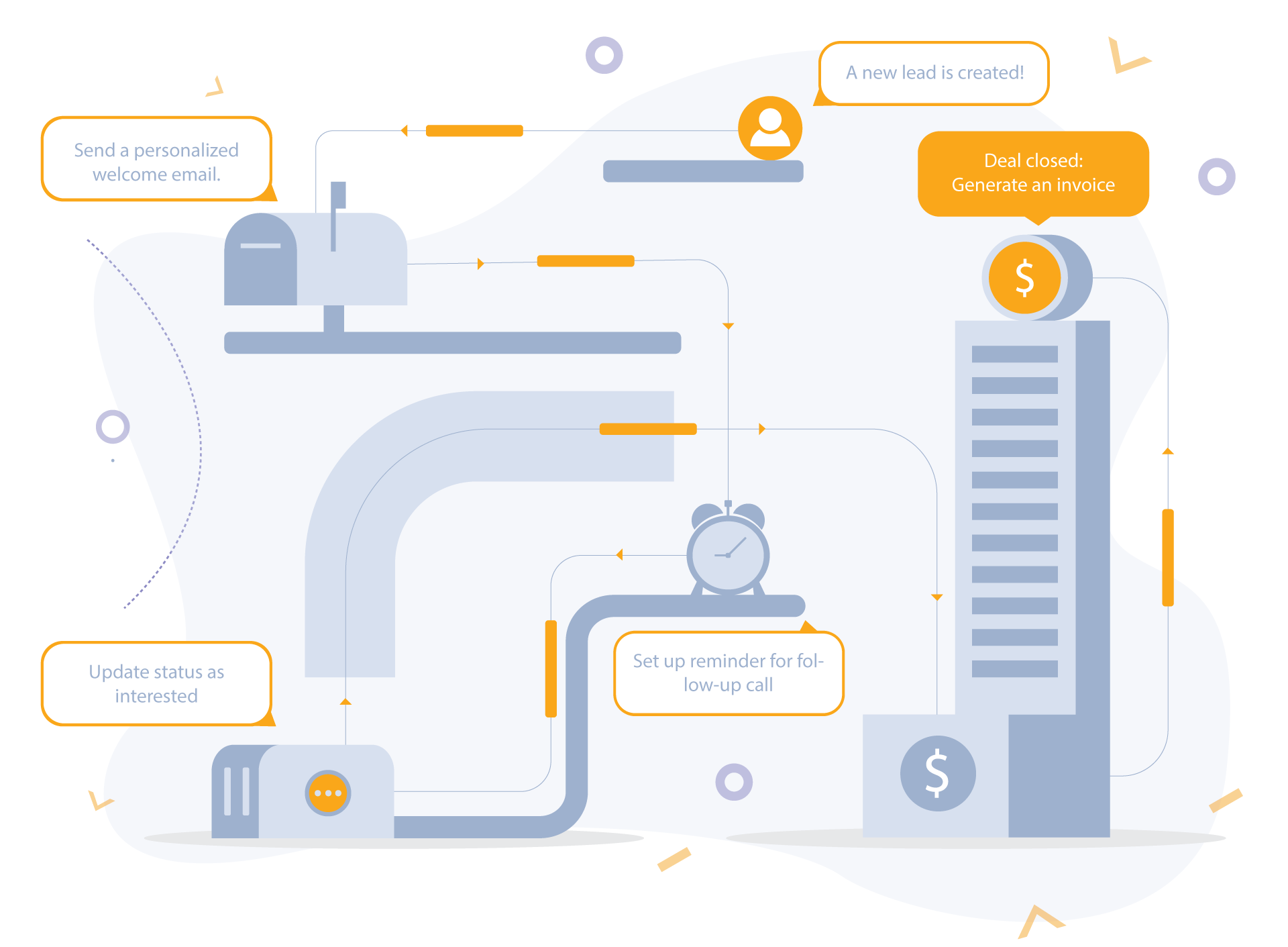Managing your customer relationships is an important and challenging job. You need to be able to keep track of your contacts, their preferences, and buying habits while trying not to annoy them with too many emails or sales pitches.
Choosing the right CRM for your marketing needs can be a difficult decision. Many factors go into this, including a budget, experience with the product, and more. But there is no need to fret! We have compiled an in-depth comparison of two popular CRMs: Redtail vs Salesforce. This blog post will walk you through what makes these two products differ from one another so that you can make an informed decision about which solution is best for your business.
What is Redtail CRM and what is used for?
Redtail CRM is a cloud-based business software that is primarily used for managing marketing and sales processes.
Redtail CRM focuses on lead generation, customer support, and feedback programs. The tools within the Redtail platform can be utilized to create personalized content such as emails or direct mailings based upon user behavior, demographics, and preferences.
Redtail CRM also integrates with several other popular software programs used by businesses, including QuickBooks, Outlook, and Google Apps.
Who uses Redtail CRM?
Redtail CRM users are typically small to medium-sized businesses who need a CRM that is both easy to use and affordable. Since Redtail CRM is web-based, it can be accessed from anywhere with an internet connection. This makes it a great choice for businesses that have employees working remotely.
RedTail vs Salesforce Features Comparison
This blog post will compare the features of Redtail and Salesforce to help you decide which CRM is the best for your marketing needs.
Salesforce is a comprehensive CRM that offers a wide range of features, including lead management, contact management, opportunity tracking, and sales pipeline reporting. It also includes built-in email marketing and social media integration.
Redtail is a more affordable CRM that offers many of the same features as Salesforce, including lead management, contact management, and opportunity tracking. It also includes built-in email marketing and social media integration. However, it does not include sales pipeline reporting or other advanced features like custom dashboards and workflow automation.
Expérience utilisateur

User experience, or UX, is the process of enhancing customer satisfaction and loyalty by improving the usability, accessibility, and pleasure provided in the interaction between a customer and a company. Simply put, it’s how well your customers like using your product or service.
It’s no secret that good UX can make or break a business. Bad user experiences cost companies 25 billion dollars each year in the United States alone. And that’s just from customers who bother to complain! Chances are good that many more people simply leave your company or product altogether without ever saying a word.
So, why is UX so important in marketing?
First, good UX is attractive. If people like using your company or product, word gets around and more customers will want to try it out. The UX you offer also makes a powerful statement about the type of business you run: if users say they love how smoothly everything works on your site, that says something good about the quality of products/services you provide as well.
Second, good UX helps you stand out from the competition. If your user experience is bad compared to that of your competitors, customers will flock to them instead. But if you have a great UX and they don’t, you’ll win their business every time.
Last, but certainly not least, good UX makes customers happy. And we all know that happy customers are more likely to be loyal, return customers.
Redtail’s user experience is significantly more pleasant and satisfying than Salesforce’s. It is easier to use, navigate, and find what you are looking for. The interface is sleek and uncluttered, with a modern look that feels current and up-to-date. In addition, Redtail offers excellent customer support in case users run into any trouble.
Salesforce, on the other hand, feels dated and cluttered. The interface is not as easy to use, and it can be difficult to find what you are looking for. In addition, Salesforce does not offer customer support unless users purchase a premium subscription.
Salesforce offers customer support only if users purchase a premium subscription, while Redtail offers customer support to all users.
Salesforce’s user experience is cluttered and difficult to use, while Redtail’s user experience is sleek, easy to use, and satisfying.
Salesforce offers customer support only if users purchase a premium subscription, while Redtail offers customer support to all users. Salesforce’s user experience is cluttered and difficult to use, while Redtail’s user experience is sleek, easy to use, and satisfying. Overall, Redtail provides an excellent user experience that is sure to please customers and help your business stand out from the competition. Salesforce, while not terrible, is lagging when it comes to user experience. If you’re looking for a CRM that your customers will love using, Redtail is the clear winner.
Flux de travail

Workflows are simply the different “steps” in your sales funnel. For example, if you are a car dealer and you want to sell new cars (high ticket items) it’s important to see where people enter your database (lead generation), what they do once inside (nurturing them into leads), then eventually closing that lead by getting them into an appointment to see a car.
Workflows allow you as a marketer to keep track of all those steps and have visibility into how your marketing efforts are performing within each step, the number of leads generated from that step, etc.
Redtail’s workflows are very simple and easy to use. You can easily create a new workflow by clicking on the “Create New Workflow” button and then selecting the type of workflow you want to create.
Redtail has four main types of workflows you can create. First, Lead Nurturing Workflow where you can easily track prospects at every step in the sales process, from lead to close. Then use this information to decide if your program is working or not and how it could be improved. You will quickly see which campaigns are driving leads most effectively and which ones need to be tweaked.
The next type of workflow is called a “Campaign Response” workflow. This allows you to track the success of your marketing campaigns by setting up rules that determine how leads should be handled when they are received as a result of a particular campaign.
Redtail’s third type of workflow is an “Event Response” workflow, which allows you to keep track of sales activity from events. You can easily create an event response that assigns a lead or opportunity depending on the type of event and then tells RedTail how to handle it automatically.
Finally, you have Lead Inflows workflows where you can set up rules for different types of leads entering your database. For example, you might be interested in setting up rules for leads that are created through your website or other online marketing efforts.
SalesForce’s workflows allow you to track people at every step of the sales process and easily see how each activity is related to revenue generation by tracking lead status, campaign results, and opportunity status.
Salesforce gives you the ability to create workflows that are triggered by any type of activity including marketing campaigns or events as well as sales activities such as calls or deals created from a lead. It will even trigger an email workflow every time there is a change in a deal record so you can follow up with your contacts promptly.
One of the unique features of SalesForce’s workflows is that it also allows you to track and measure marketing ROI (return on investment) because you can see what revenue was generated from each workflow, who initiated it, when they did, etc., which makes for great analytics data.
In terms of workflows, Redtail is much simpler to use and SalesForce offers more complex options. However, what SalesForce lacks in simplicity it makes up for in analytics data that can help you measure the ROI of your marketing campaigns. Ultimately, which CRM you decide to go with depends on your needs and how comfortable you feel using its features.
Reporting

Reporting is one of the most important features of a CRM because it allows you to track your progress and see what is or isn’t working. With Salesforce, you can easily create reports on everything from lead conversion rates to email open rates. Redtail also offers robust reporting capabilities, making it easy to track your marketing efforts and measure their impact.
Some of the key features that Marketing teams will find useful are; First, Productivity Reports where you track how much time your team is spending on tasks and what components they may be neglecting. Second, Opportunity Reports allow you to track how many opportunities your marketing efforts are creating and converting. Finally, Email Statistics Reports show you how many emails were sent, opened, clicked through, and more.
Redtail’s reporting capabilities are extensive and customizable. You can track just about anything you want, including email opens, clicks, and conversions; social media interactions; website visits; and more. You can also create custom reports to suit your specific needs.
Redtail offers several different report types, including standard reports, activity reports, contact reports, and more. You can also save your favorite reports for easy access later on.
You can export Redtail’s reports to Excel, PDF, or CSV files for further analysis or distribution. And if you need help creating custom reports or understanding the data in your existing reports, the Redtail support team is standing by.
Salesforce offers reporting capabilities that are just as robust and customizable as those offered in Redtail; however, since they’re part of a larger suite, you can access all your other data from within your reports. That means no more exporting and importing – you can pull all your marketing data into a single report.
Salesforce’s reporting capabilities allow you to track website visits, social media interactions, email opens and click-through rates, lead conversions/completions, opportunities created by your team members or from within the system itself (like at trade shows), customer surveys completed, and more.
You can also filter your reports by date range, activity type (social media interactions or email opens), contact status, campaign name/type, lead source, product purchased – the possibilities are nearly endless! You can even create custom dashboards for quick access to any data you want to track right at your fingertips.
In terms of reporting, Redtail and Salesforce are very different. Redtail offers extensive reporting capabilities, giving you access to information on just about everything your team is doing in the marketing department. But if you need a deeper dive into this data or want to pull it all together in one place for easy analysis, Salesforce’s reporting features might be a better fit.
Third-Party Integration

Third-party integration is a crucial part of marketing. When you are integrating different software, it allows for seamless workflows across all of your business needs.
Third-party integration allows you to connect different software to automate tasks and better manage your data. This is important for marketing because it can help you track leads, customers, and sales more effectively.
When looking for a CRM, make sure to find one that has good Third-Party Integration options. This will make your life much easier when it comes to managing your marketing tasks.
Redtail’s third-party integration options are one of the best parts of their CRM. They have over 100+ plugins and integrations that you can use to connect almost any software with Redtail.
Some of the most popular third-party programs include HubSpot, MailChimp, Marketo, SalesforceIQ (formerly Rypple), Slack, Zoho, and more.
When you start using Redtail’s CRM software you can connect all of your different marketing tools to make data management seamless and easy!
Redtail’s third-party integration is a huge plus that makes their CRM stand out from the rest.
Salesforce’s third-party integration is also very good. They have over 40+ apps that you can use to connect different software with Salesforce.
Some of the most popular third-party programs include HubSpot, MailChimp, Marketo (SalesforceIQ), Pardot (SalesforceIQ), and more!
When it comes down to it their Third-Party Integration is not quite as extensive as Redtail, but it still has some great options that will make your life easier.
The bottom line here is both CRM’s have good Third-Parties for different areas of marketing. Each one offers different third-party programs to help streamline your workflow and improve data management across all of your different marketing tools.
In terms of third-party integration, both Redtail and Salesforce are good options for any marketing team.
Redtail has a ton of different third-party apps that you can use to connect almost anything with their CRM, which is great! But they also have some competitors like Marketo (SalesforceIQ) who offer a lot of the same integrations as well.
Salesforce also has a lot of different integrations, but they don’t quite have as many as Redtail. However, they do offer some unique integrations that you can’t find with any other CRM.
At the end of the day, both CRM’s are great for marketing teams and have a variety of third-party integration options to choose from. It just depends on your team’s specific needs and what programs you want to connect with your CRM.
Gestion des opportunités

La gestion des opportunités est le processus de suivi et de gestion des opportunités de vente potentielles. Cela inclut l'enregistrement des informations concernant une opportunité, son statut actuel et toute action associée.
La gestion des opportunités est importante pour le marketing car les marketeurs doivent être en mesure de suivre leurs performances en matière de conversion des leads en opportunités avant de les transmettre aux représentants commerciaux. Cela permet également aux marketeurs de savoir sur quoi ils doivent s'améliorer.
C'est une partie importante de toute stratégie marketing efficace, car cela vous permet de garder une trace de tous les leads sur lesquels vous travaillez, ainsi que de prioriser et de suivre leur progression.
Le système de gestion des opportunités de Redtail est très complet. Vous pouvez suivre l'avancement de chaque opportunité, ainsi qu'ajouter des notes et des documents pour vous aider à garder une trace de tout ce qui est lié à cette opportunité.
Vous pouvez également créer des champs personnalisés pour suivre toute information qui est importante pour vous, et plusieurs rapports sont disponibles pour vous aider à suivre comment vos opportunités se portent.
Le système de gestion des opportunités de Redtail est très bon pour les équipes marketing.
Le système de gestion des opportunités de Salesforce est également complet, mais il n'a pas certaines fonctionnalités disponibles dans Redtail. Vous ne pouvez pas créer de champs ou de rapports personnalisés, donc vous êtes limité à ce qu'ils proposent.
Il dispose de nombreuses fonctionnalités utiles pour les équipes de vente, mais il n'est pas aussi bon pour les équipes marketing.
Le système de gestion des opportunités de Salesforce est plus axé sur les ventes que sur le marketing.
En termes de gestion des opportunités, Redtail est le meilleur choix pour les équipes marketing. Il y a plus de fonctionnalités disponibles, et il est conçu avec les marketeurs à l'esprit.
Salesforce a beaucoup de fonctionnalités excellentes axées sur les ventes qui seraient bonnes pour les représentants commerciaux, mais il n'y a pas autant de fonctionnalités disponibles ni de système de gestion des opportunités complet pour les marketeurs.
Mobile

Les capacités mobiles sont importantes pour tout CRM car elles vous permettent d'accéder à vos données et contacts de n'importe où. Redtail propose une application mobile disponible sur les appareils Android et iOS, tandis que Salesforce n'a pas son application mobile mais propose une version mobile de son site web.
Le mobile est important car il vous donne la liberté de travailler sur votre CRM n'importe où. Si vous êtes hors du bureau, vous pouvez toujours accéder à vos données et contacts pour accomplir votre travail. L'application mobile de Redtail est disponible sur les appareils Android et iOS, tandis que Salesforce n'a pas son application mobile mais propose une version mobile de son site web.
L'application mobile de Redtail est très complète et offre toutes les fonctionnalités que vous pouvez attendre d'une application mobile CRM. Vous pouvez accéder à vos contacts, comptes, opportunités et tâches ; consulter des rapports, et même créer de nouveaux enregistrements. L'application est facile à utiliser et dispose d'une interface conviviale.
Redtail dispose d'une application mobile complète qui offre toutes les fonctionnalités que vous pouvez attendre d'une application mobile CRM. Vous pouvez accéder à vos contacts, comptes, opportunités et tâches ; consulter des rapports, et même créer de nouveaux enregistrements. L'application est facile à utiliser et dispose d'une interface conviviale.
Salesforce n'a pas son application mobile, mais la version mobile de son site web est très bonne. Elle est facile à naviguer et offre toutes les fonctionnalités que vous pouvez attendre d'un CRM sur un appareil mobile. Vous pouvez accéder à vos contacts, comptes, opportunités et tâches ; consulter des rapports, et créer de nouveaux enregistrements.
En termes de mobile, Redtail et Salesforce sont à égalité. Les deux offrent des applications mobiles complètes avec toutes les fonctionnalités que vous pouvez attendre d'un CRM sur un appareil mobile. Cependant, l'application de Redtail est disponible sur les appareils Android et iOS, tandis que l'application de Salesforce n'est disponible que sur les appareils iOS. Cela pourrait être un facteur important si vous avez des employés utilisant des appareils Android.
Redtail a une application mobile disponible sur les appareils Android et iOS. Le site web de Salesforce est adapté aux mobiles mais n'a pas d'application dédiée. Redtail propose des fonctionnalités plus complètes que Salesforce dans le domaine mobile, ce qui pourrait en faire la meilleure option pour vous selon vos besoins.
Facilidad de uso

La facilité d'utilisation est un facteur important à considérer lors du choix d'un CRM pour vos besoins marketing.
La facilité d'utilisation jouera un rôle significatif dans la rapidité avec laquelle votre équipe peut apprendre et utiliser le CRM. Plus il vous faudra de temps pour former les employés, les intégrer et les familiariser avec le logiciel – cela limite les ressources pour d'autres initiatives marketing.
La facilité d'utilisation dépendra de nombreux facteurs tels que l'interface utilisateur, la navigation, la disponibilité des fonctionnalités et le service client.
La facilité d'utilisation de Redtail dépend fortement de l'interface utilisateur. Par exemple, leur fonctionnalité de glisser-déposer permet aux utilisateurs de créer facilement de nouvelles campagnes et de cibler des clients spécifiques sans écrire une seule ligne de code.
Leur navigation est également simple avec moins de clics nécessaires pour la plupart des tâches, ce qui signifie que vous pouvez accomplir plus d'actions en moins de temps. L'interface "daylight" de Redtail donne aux marketeurs la possibilité de voir l'ensemble de leur pipeline d'un coup d'œil, facilitant l'identification de tout goulot d'étranglement potentiel.
Salesforce est moins dépendant de l'interface utilisateur et plus de la disponibilité des fonctionnalités. Bien qu'ils aient une fonctionnalité de glisser-déposer, elle n'est pas aussi conviviale que celle de Redtail.
La navigation est également plus compliquée que dans Redtail, avec plus de clics nécessaires pour atteindre la tâche souhaitée. Salesforce propose une interface "dark" qui permet aux utilisateurs de masquer ou d'afficher des objets et des onglets en fonction de leurs besoins. Cependant, cela peut être déroutant pour les utilisateurs débutants.
En termes de facilité d'utilisation, Redtail est le gagnant évident. Leur fonctionnalité de glisser-déposer facilite la création de campagnes et le ciblage de clients spécifiques sans nécessiter de codage. De plus, leur navigation est simple, ce qui permet aux marketeurs d'accomplir des tâches en moins de temps. La facilité d'utilisation de Salesforce est moins dépendante de l'interface utilisateur et plus de la disponibilité des fonctionnalités. Bien qu'ils aient une fonctionnalité de glisser-déposer, elle n'est pas aussi conviviale que celle de Redtail et leur navigation est plus compliquée que dans Redtail avec plus de clics nécessaires pour atteindre la tâche souhaitée.
Gestion des contacts

La gestion des contacts est importante en marketing car elle vous permet de garder une trace de tous vos leads et clients en un seul endroit. Cela facilite l'organisation et le suivi des opportunités de vente potentielles.
Les leads sont une opportunité en attente, prêts à agir lorsqu'ils deviennent prêts à acheter. Un lead peut être défini comme toute personne ayant interagi avec votre entreprise d'une manière ou d'une autre, que ce soit en remplissant un formulaire sur votre site web ou en passant simplement à proximité et en voyant vos supports promotionnels.
Un client est quelqu'un qui a déjà acheté chez vous et représente donc un flux de revenus existant. Il est important de maintenir des relations avec vos clients pour qu'ils se sentent valorisés et continuent à acheter chez vous.
Redtail’s contact management is pretty straightforward. It starts by creating an account, which means you can start adding contacts immediately after signing up. But the real beauty here is in how those contacts are organized and labeled – a simple click will switch between your leads, customers, or prospects as needed.
Redtail also allows you to track your interactions with each contact, so you can always be sure of the last time you contacted them and what that interaction consisted of. This helps keep your sales process organized and streamlined.
Salesforce’s contact management is a little more complicated than Redtail’s but still user-friendly. To create a contact, you first need to set up a custom object – this is where all your customer data will live. From there, you can add fields for any information you want to track about each customer (including interactions).
Salesforce also offers several features for managing leads and customers, such as lead nurturing, campaign management, and reporting. However, it can be a little more difficult to find the information you need than in Redtail.
In terms of contact management, Redtail and Salesforce are both great options. Redtail is simpler to use but doesn’t offer as many features, while Salesforce is more complicated but has a wider range of features. Ultimately, which CRM you choose will depend on your individual needs and preferences.
Both CRMs have their pros and cons, but at the end of the day it comes down to what you need most from a CRM. If you’re looking for a simple way to keep track of all your leads and customers, Redtail is the way to go. But if you need more features and flexibility, Salesforce is a good option.
Social Integration

Social integration is the process of connecting and sharing information across different social media platforms.
The ability to quickly share your content on multiple social channels is essential in today’s marketing world, where customers expect real-time responses. They also want a streamlined experience that allows them to interact with you through one or all of their preferred networks – be it Facebook, Twitter, Pinterest, or LinkedIn.
With social integration, your marketing team can easily share any content that you want to promote across all of your networks without having to manually enter the same message multiple times.
Redtail’s social integration tool allows you to quickly and easily share content from your CRM on all of your social media channels. You can also use it to monitor your social media feeds for any mentions of your company or products, and then respond directly from within Redtail.
This tool is a great way to keep your social media accounts active and engaged with your customers, even when you’re not constantly posting updates!
SalesForce’s Chatter allows users to share content from their CRM with any social media platform. This includes Facebook, Google+, Twitter, and LinkedIn. In addition, they can also monitor these channels for any posts related to them or their company and then respond directly from within Salesforce.
This tool is a great way to keep your social media accounts active and engaged with your customers, even when you’re not constantly posting updates!
Both Redtail’s and SalesForce’s social integration tools are great ways to automate your social media management. However, Redtail’s tool lets you post to more social networks than SalesForce.
This shows that the best CRM for marketing is Redtail!
In terms of social integration, it’s clear that Redtail CRM is the superior option. It allows you to post on more social networks, which makes it easier for your marketing team to share content across all of their channels without having to manually enter the same message multiple times.
Also, since social integration involves sharing content from your CRM directly with less effort involved, this will help keep your social media accounts active and engaged with your customers. So, if you’re looking for an easy way to boost your marketing efforts, Redtail is the best CRM for you!
Analyse & Tableau de bord

Analytics & dashboard is a feature that allows you to track your progress and measure your success. With this information, you can make improvements to your campaigns and strategies. It is important in marketing because you need to be able to track your progress and make changes accordingly.
Analytics is a feature that is used to track your campaigns, marketing efforts, and improvements. This information will be laid out in an easy-to-understand format that can allow you to see what is working well for your business and the areas that need improvement.
The dashboard allows you to get a quick look at how effective your current advertising campaign is, without having to dig through your analytics. It can give you information as ad spend, clicks, and conversions to help figure out the best course of action for improving it or continuing as-is.
Redtail’s Analytics & Dashboard is very user-friendly and easy to navigate. The layout is simple, which makes it easy to find the information you need. There are several different options for viewing your data, so you can customize it to fit your needs. You can also export your data into a variety of formats for further analysis or sharing with others.
Redtail’s analytics feature is a great way to view your progress and determine whether or not you are reaching the goals of your campaign. It also gives insight into what areas need improvement so that you can optimize for success.
Redtail’s dashboard is also very user-friendly. It provides a quick overview of your data, so you can see how your campaigns are doing at a glance. You can customize it to show the information that is most important to you, and export it into different formats for further analysis or sharing with others.
Salesforce’s analytics & dashboard is also very user-friendly. The layout is simple and easy to understand, so you can find the information you need quickly. There are several different options for viewing your data, so you can customize it to fit your needs. You can also export your data into a variety of formats for further analysis or sharing with others.
Salesforce’s analytics feature is a great way to view your progress and determine whether or not you are reaching the goals of your campaign. It also gives insight into what areas need improvement so that you can optimize for success.
Salesforce’s dashboard allows you to get a quick look at how effective your current advertising campaign is, without having to dig through your analytics.
In terms of analytics & dashboard, both Redtail and Salesforce have some great features that can help you track your marketing progress and measure your success. However, we feel that Redtail’s analytics & dashboard is a bit more user-friendly and easier to navigate. It also provides more options for viewing your data, so you can customize it to fit your needs. Additionally, the layout is simple, making it easier to find the information you need.
Gestion des leads

Lead management is the process of tracking, managing, and nurturing leads through the sales pipeline until they are converted into customers. It’s a critical part of any successful marketing strategy, as it helps you ensure that your efforts are focused on quality leads that have the greatest potential to become paying customers.
Lead management is one of the most important parts of marketing because it ensures you are spending your time and resources on qualified leads that have shown interest in your company’s products or services. Unfortunately, many marketers struggle with lead management due to what they perceive as a lack of tools offered by their CRM vendor. This often results in poor data quality, wasted time and effort, and unqualified leads.
Redtail’s lead management capabilities are built right into the platform. The Lead Scoring feature automatically evaluates incoming leads based on pre-defined criteria, allowing you to prioritize your prospects for follow-up and ensure that your efforts are focused on generating qualified opportunities.
Redtail’s lead scoring feature makes it easy to pre-qualify leads.
Salesforce, on the other hand, does not include a built-in lead management function within its CRM platform. This means that marketers must rely on third-party solutions to manage their leads and ensure they are moving through each stage of the sales pipeline.
When third-party solutions are required, marketers must decide which one to use. This can be challenging given that there is no single solution designed specifically for Salesforce, meaning you’ll need to compare several different options and choose based on your specific criteria (price point, ease of use, etc.).
The lack of lead management capabilities in Salesforce is a major drawback for marketers.
In terms of lead management, Redtail and Salesforce are fairly evenly matched. However, Redtail’s lead scoring feature makes it easier to pre-qualify leads, which can be a major advantage for businesses that want to focus their efforts on generating qualified opportunities. Ultimately, the best CRM for your marketing needs will depend on your specific requirements and preferences. So, be sure to take the time to research your options before making a decision.
Essai gratuit
Getting a free trial can be an extremely valuable option for many companies. It is important because it allows the potential customer to get used to using your product before they have to pay money, which oftentimes makes them more likely to purchase and subscribe.
Redtail’s free trial offers unlimited access to their CRM for 14 days. This trial is great for those who want to explore the features of Redtail or want to test it out before making a purchase.
Redtail offers a free trial, which may make it more attractive to potential customers. Another advantage is that you can also install Redtail on your server where they will host all of the data for you so there are no extra fees or security risks with having them store your information with their cloud-based CRM.
Salesforce also offers a free trial, which is important for those who want to test out the features of this CRM before making a purchase. The trial lasts for 14 days and you have access to all of the features of Salesforce. You can also use Salesforce’s CRM on your server where they will host all of the data for you so there are no extra fees or security risks.
In terms of a free trial, both Redtail and Salesforce offer great options for those who want to explore the features of each CRM before making a purchase. However, Redtail’s free trial is more advantageous because it offers unlimited access to their CRM for 14 days, while Salesforce only offers 14 days of access.
Tarification

Note: Prices may be subject to change.
Pricing is important for a couple of reasons. First, it helps businesses determine whether they can afford a certain product or service. Second, it allows customers to compare products and services to see which one offers the best value. Finally, it can help businesses attract new customers by advertising lower prices than their competitors.
Redtail’s pricing is based on the number of contacts you want to store in your customer database. They offer five different plans, ranging from $19 per month for 500 contacts up to $699 for 25,000 contacts.
The basic plan costs just under 50 dollars a month and includes all the essential marketing tools that small businesses need to get started. Also, our plan includes additional features, such as email marketing and lead scoring. You can find out more information on our pricing page.
SalesForce’s prices vary depending upon the size of your business and what you need from a CRM system. The cheapest option is $65 per user per month for up to five users.
Salesforce pricing starts at a minimum of about 150 dollars per month and goes up from there depending on the size of your business and what you want from a CRM system.
Salesforce’s pricing is based on the number of users you want to add to your account. They offer three different plans, ranging from $25 per month for one user up to $300 per month for 25 users.
In terms of pricing, Redtail is a much better option compared to SalesForce. Redtail’s pricing starts at just under 50 dollars a month, which includes essential marketing tools that small businesses need to get started. Also, our plan includes additional features such as email marketing and lead scoring. You can find out more information on our pricing page. On the other hand, SalesForce’s prices vary depending upon the size of your business and what you need from a CRM system. The cheapest option is $65 per user per month for up to five users, which means that SalesForce would cost you around 250 dollars every single month!
Questions fréquemment posées
Who’s more expensive? Salesforce CRM or RedTail EDI?
In terms of expensiveness, Salesforce CRM is more expensive than RedTail EDI. Salesforce can be quite costly for businesses that are just starting out, whereas RedTail EDI has a range of pricing options to fit any company’s budget. That said, it’s important to remember that you get what you pay for; with Salesforce, you’re getting a powerful marketing and sales platform that can be incredibly beneficial to your business.
Quel logiciel inclut plus/mieux de fonctionnalités ?
The software that offers better and more features is Salesforce.
Salesforce has a customizable user interface (UI): Depending on your business preferences, you can set up a UI that works for you and other users in your company. This allows everyone to use it more efficiently without feeling confused or overwhelmed by its complexity. You can also manage an unlimited number of leads, accounts, contacts, and opportunities with Salesforce. Another feature of salesforce is that you can manage your email marketing and social media in one place. You can also connect with customers via text messaging, which is a great option for increasing sales conversions. Salesforce’s reporting engine provides an enormous amount of data to marketers about their lead generation campaigns so they know what works best for them.
Redtail does not offer the same level of customization for users. Its UI is more traditional and less flashy than Salesforce. Additionally, it has limited lead management capabilities in comparison to Salesforce. If your business depends on managing a high volume of leads, you might find Redtail’s product a little limiting.
Which is the best CRM for financial advisors?
The best CRM for financial advisors is Salesforce.
Redtail has excellent reporting features that can provide you with all the information about your client in one place, but Salesforce is enterprise-level software that’s more complex and better suited for larger teams of financial advisors.
SalesForce also integrates easily with other software such as Google Docs and Microsoft Excel, which can make it a more powerful tool for your marketing needs. If you’re looking for a CRM that will help you manage your clients and their data effectively, then Salesforce is the best option.
If you’re not sure whether Salesforce or Redtail is the best CRM for you, then speak to a representative from each software company and ask them which program would be better suited for your needs. They’ll be able to provide you with more information and help you make a decision.
What does a CRM for financial advisors typically include?
Financial advisors are typically looking for social media, lead capture, and reporting capabilities. Social Media Management, Lead Capture & Leads Tracking, Reporting & Analytics are all important features to look for in a CRM.
Salesforce est généralement considéré comme la meilleure option pour ces besoins, car il offre des capacités de gestion des réseaux sociaux robustes, des formulaires de capture de leads personnalisables et traçables, ainsi que des rapports et analyses détaillés. Cependant, Redtail propose également de solides outils de gestion des réseaux sociaux, de bonnes options de capture de leads et des fonctionnalités de reporting robustes.
Quel CRM est le meilleur pour vos besoins marketing ? Cela dépend de ce que vous recherchez dans un CRM. Si vous avez besoin de capacités de gestion des réseaux sociaux robustes, de formulaires de capture de leads personnalisables et traçables, ainsi que de rapports et d'analyses détaillés, alors Salesforce est probablement la meilleure option pour vous. Cependant, si vous recherchez une option plus abordable qui offre également de bons outils de gestion des réseaux sociaux, de bonnes options de capture de leads et des fonctionnalités de reporting robustes, alors Redtail pourrait être la meilleure option.
Quel est le meilleur, Salesforce Financial Services Cloud ou RedTail ?
Entre Salesforce Financial Services Cloud et Redtail, il peut être difficile de décider quel CRM est le meilleur pour vos besoins marketing. Les deux ont leurs avantages et inconvénients, mais au final, cela dépend de vos besoins spécifiques.
Salesforce Financial Services Cloud est idéal pour les entreprises qui ont besoin de beaucoup d'automatisation et de fonctionnalités intégrées. Il est parfait pour les entreprises en croissance qui souhaitent pouvoir évoluer à mesure qu'elles se développent, car il peut être facilement adapté et étendu. Il offre également de nombreuses options d'intégration intéressantes, vous n'avez donc pas à tout configurer à partir de zéro et à utiliser d'autres produits ou services qui pourraient ne pas bien fonctionner avec votre système.
RedTail est idéal pour les entreprises qui veulent quelque chose de simple, facile à utiliser et abordable. Il est préférable pour les startups ou les entreprises qui commencent à croître mais qui ne sont pas encore prêtes à investir dans quelque chose comme Salesforce Financial Services Cloud. Bien qu'il n'ait pas autant de fonctionnalités, RedTail est toujours très efficace dans ce qu'il fait, car tous les outils les plus importants dont vous avez besoin pour l'automatisation marketing sont inclus.
En fin de compte, cela dépend de ce que vous recherchez et de vos besoins spécifiques. Si vous voulez quelque chose de facile à utiliser et avec beaucoup de fonctionnalités, optez pour Salesforce Financial Services Cloud. Si vous voulez quelque chose de plus abordable et simple, choisissez RedTail. Quel que soit le CRM que vous choisissez, assurez-vous de prendre le temps de l'apprendre à fond afin de pouvoir en tirer le meilleur parti !
Conclusion : Quel est le meilleur – Salesforce CRM ou RedTail ?
À la fin de la journée, le CRM que vous choisissez dépend de vos besoins spécifiques en tant qu'entreprise. Si vous recherchez un système tout compris qui peut gérer tout, des ventes et du marketing au service client et à la comptabilité, Salesforce est probablement votre meilleur choix. Cependant, si vous recherchez principalement un outil CRM puissant pour vous aider à gérer vos efforts marketing, RedTail offre l'ensemble d'outils le plus complet pour cela.
En fin de compte, les deux CRMs sont d'excellentes plateformes avec de solides fonctionnalités qui peuvent aider à rationaliser de nombreux aspects de la gestion d'entreprise. Par conséquent, cela dépend de vos besoins spécifiques en tant qu'entreprise et de celui qui correspond le mieux à ces exigences.
Salesforce est un excellent CRM pour les entreprises qui recherchent un système tout compris pour gérer les ventes, le marketing, le service client et la comptabilité. Cependant, si vous recherchez principalement un outil CRM puissant pour vous aider à gérer vos efforts marketing, RedTail offre l'ensemble d'outils le plus complet. Donc, en résumé, les deux CRMs sont d'excellentes plateformes avec de solides fonctionnalités pour aider à rationaliser de nombreux aspects de la gestion d'entreprise.





